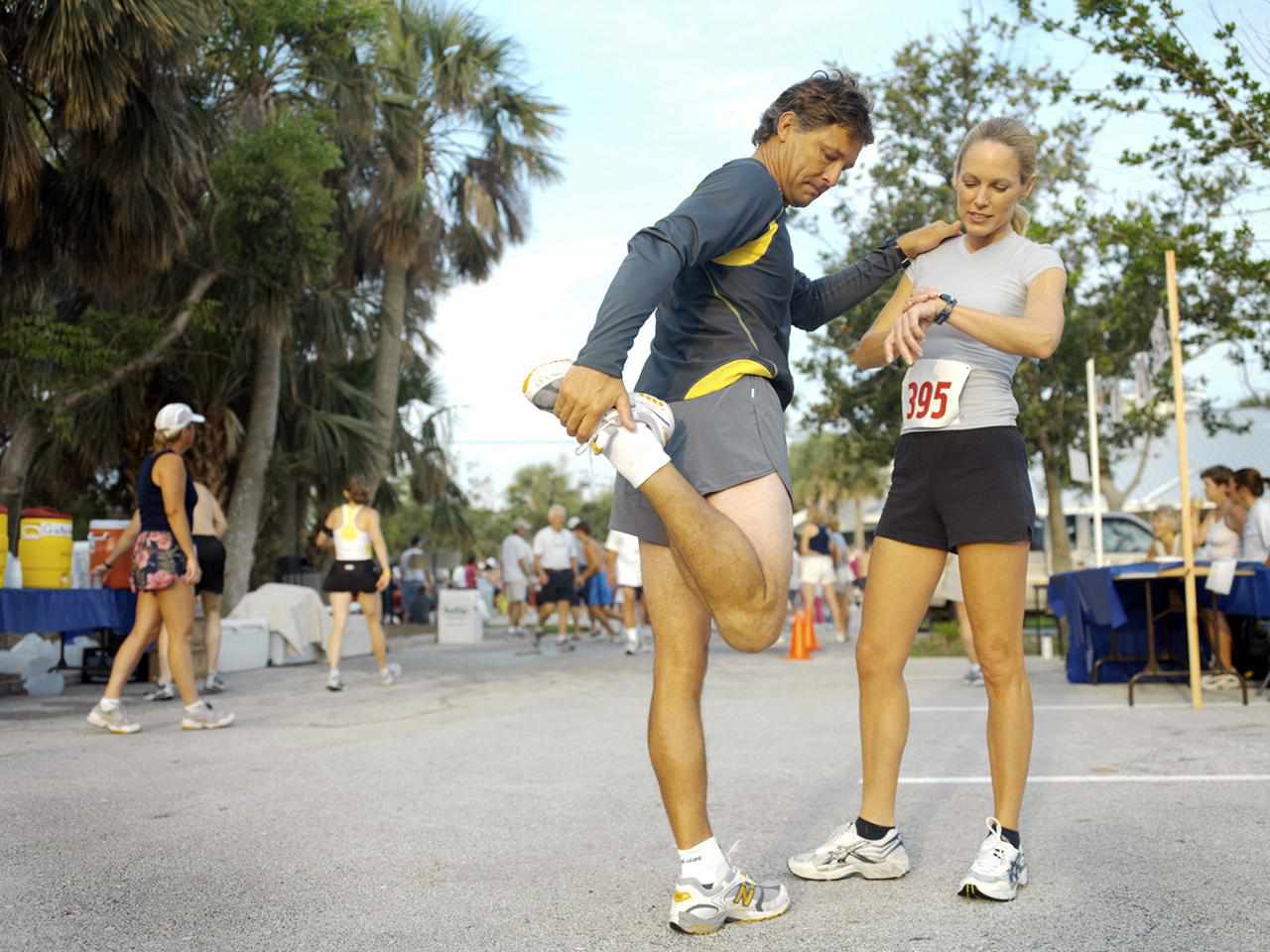Home>Misc>Featured>How Long Distance Running Affects The Body


Featured
How Long Distance Running Affects The Body
Modified: January 22, 2024
Discover the incredible effects of long distance running on your body. Learn how this featured activity improves cardiovascular health and boosts endurance.
Introduction
Long distance running is a demanding endurance activity that pushes the limits of the human body. It goes beyond the typical jog around the park and requires immense physical and mental strength to cover significant distances. Whether you are a professional athlete or a recreational runner, engaging in long distance running can have a profound impact on your body.
While many individuals are drawn to long distance running for its physical and mental health benefits, it is essential to understand the effects it can have on your body. From muscular adaptations to cardiovascular changes, long distance running can lead to both positive and negative outcomes.
This article will explore the various ways in which long distance running affects the body. We will discuss how it impacts muscles, joints, and bones, as well as the changes that occur in the cardiovascular and respiratory systems. Additionally, we will delve into the hormonal and immune system effects, as well as the mental and psychological impact of long distance running. It is crucial to highlight the nutritional considerations for long distance runners, along with strategies to prevent injuries. Finally, we will provide recommendations for long distance runners to optimize their performance and maintain a healthy body.
Whether you are an experienced long distance runner or considering taking up the challenge, understanding the effects on your body is vital. By being aware of these impacts, you can make informed decisions about your training routine, nutrition, and overall well-being. Let’s dive into the fascinating world of long distance running and explore how it shapes the body.
Impact on Muscles
Long distance running places significant stress on the muscles, leading to various adaptations and changes. As you increase your mileage and train for longer distances, your muscles undergo both structural and functional transformations.
One of the primary effects of long distance running on muscles is an increase in endurance. The repetitive nature of running for extended periods improves the oxidative capacity of the muscles. This means that the muscles become more efficient at utilizing oxygen and producing energy, allowing you to sustain a steady pace for longer durations.
Furthermore, long distance running also leads to an increase in muscle fiber size and density. Through the process of hypertrophy, the muscles adapt to the repeated stress and strain by growing larger and stronger. This not only enhances your overall running performance but also provides better support and stability to the joints.
However, it’s important to note that long distance running primarily targets slow-twitch muscle fibers. These fibers are responsible for prolonged, endurance-based activities. As a result, the fast-twitch muscle fibers, which are responsible for explosive movements, may not experience the same level of development during long distance running.
In addition to these positive adaptations, long distance running can also lead to muscle imbalances and overuse injuries. The repetitive nature of the activity can cause certain muscles to become overdeveloped while neglecting others. It’s crucial to incorporate strength training exercises and cross-training activities to maintain muscular balance and minimize the risk of injuries.
Overall, long distance running has a profound impact on the muscles. It improves endurance, increases muscle fiber size, and enhances stability. However, it’s important to address muscle imbalances and incorporate strength training to prevent injuries and maintain overall muscle health.
Effects on Joints and Bones
Long distance running can have both positive and negative effects on the joints and bones. While the activity provides numerous health benefits, it also places substantial stress on these vital structures.
One of the positive impacts of long distance running on joints is that it can increase their strength and stability. The repetitive impact and weight-bearing nature of running stimulate the production of synovial fluid, which nourishes the joints and helps maintain their health. Additionally, running can improve bone density, reducing the risk of osteoporosis and fractures.
However, the continuous impact and repetitive movements involved in long distance running can also lead to joint injuries, particularly in the knees and ankles. The excessive stress placed on these joints can cause inflammation, pain, and even long-term damage if not properly managed.
To minimize the risk of joint injuries, proper footwear and running technique are crucial. Investing in well-cushioned and supportive shoes can alleviate some of the impact on the joints. Additionally, maintaining proper form and avoiding overstriding can help distribute the forces more evenly throughout the lower body.
It’s also important to listen to your body and give it adequate rest and recovery time. Overtraining and pushing through pain can lead to chronic joint issues, so it’s essential to balance your training with sufficient rest days and cross-training activities.
Incorporating strength training exercises into your routine is another effective way to support joint health. Strengthening the muscles around the joints can provide added stability and reduce the strain on these structures during long distance running.
Overall, long distance running can improve joint strength and bone density, but it also carries the risk of joint injuries. By taking appropriate precautions and listening to your body, you can minimize the negative effects and enjoy the benefits of this endurance activity.
Cardiovascular Changes
Long distance running has a profound impact on the cardiovascular system, leading to various changes and adaptations that improve overall heart health and endurance.
One of the primary effects of long distance running on the cardiovascular system is an increase in stroke volume. Stroke volume refers to the amount of blood the heart pumps with each contraction. Through consistent aerobic exercise like long distance running, the heart becomes more efficient and can pump a larger volume of oxygenated blood to the working muscles.
Long distance running also leads to an increase in cardiac output, which is the total amount of blood pumped by the heart per minute. As the heart adapts to the demands of prolonged running, it becomes stronger and more efficient, resulting in a higher cardiac output. This increase in cardiac output helps deliver more oxygen and nutrients to the muscles and organs, enhancing overall performance.
Additionally, long distance running promotes the growth of new blood vessels, a process known as angiogenesis. This vascular development improves circulation and increases the oxygen supply to the muscles. It also enhances the body’s ability to remove waste products, such as carbon dioxide and lactic acid, which are produced during exercise.
Furthermore, long distance running can lead to a decrease in resting heart rate. As the heart becomes more efficient, it doesn’t have to work as hard to supply the body with oxygen. This results in a lower resting heart rate and a reduced risk of cardiovascular diseases such as hypertension and heart disease.
It’s crucial to note that these cardiovascular changes are not immediate and require consistent training over an extended period. It’s essential to gradually increase your mileage and intensity to allow the cardiovascular system to adapt and avoid overexertion.
Overall, long distance running has significant cardiovascular benefits, improving stroke volume, cardiac output, and vascular development. These adaptations enhance heart health, increase endurance, and lower the risk of cardiovascular diseases.
Respiratory System Adaptations
Long distance running not only challenges the cardiovascular system but also leads to important adaptations in the respiratory system. These changes allow the body to meet the increased oxygen demand during endurance activities.
One of the primary adaptations of the respiratory system in response to long distance running is an increase in lung capacity. Regular running engages the respiratory muscles, such as the diaphragm and intercostal muscles, making them stronger and more efficient. This results in a greater volume of air that can be inhaled and exhaled with each breath, improving oxygen intake during exercise.
Furthermore, long distance running enhances the efficiency of gas exchange in the lungs. The increased demand for oxygen during exercise prompts the body to optimize the diffusion of gases in the alveoli, the tiny air sacs in the lungs. This allows for more efficient transfer of oxygen from the lungs to the bloodstream and the removal of carbon dioxide.
Another important adaptation is an improvement in breathing control and efficiency. Long distance runners develop the ability to regulate their breathing and maintain a steady rhythm even during intense exercise. This allows for better oxygen delivery to the muscles and helps prevent the buildup of lactic acid, delaying fatigue.
It’s important to note that these respiratory adaptations are not immediate and require consistent training over time. Gradually increasing the intensity and duration of your runs will allow the respiratory system to adapt and improve its efficiency.
It is worth mentioning that proper breathing techniques, such as diaphragmatic breathing, can further optimize respiratory efficiency during long distance running. Engaging the diaphragm and breathing deeply from the abdomen allows for a more efficient use of the lungs and ensures an adequate oxygen supply to the muscles.
In summary, long distance running leads to important adaptations in the respiratory system, including increased lung capacity, improved gas exchange efficiency, and enhanced breathing control. These adaptations contribute to better oxygen delivery, improved endurance, and overall performance during endurance activities.
Hormonal and Immune System Effects
Long distance running exerts significant influence on the hormonal and immune systems, playing a role in both positive adaptations and potential challenges faced by the body.
During long distance running, the body releases endorphins, known as the “feel-good” hormones. These endorphins help create a sense of euphoria and reduce stress levels, contributing to the psychological benefits of the activity. Additionally, running stimulates the production of other hormones, such as serotonin and dopamine, which promote a positive mood and mental well-being.
Long distance running also influences the immune system. Moderate-intensity endurance exercise has been shown to enhance immune function. Regular running can increase the production and activity of immune cells, improving the body’s ability to defend against pathogens and reduce the risk of illnesses.
However, it’s important to note that excessive or intense exercise, such as overtraining or participating in long distance races without proper recovery, can have negative effects on the immune system. The stress placed on the body can lead to a temporary decrease in immune function, increasing the susceptibility to infections and illnesses.
In addition to these hormonal and immune system effects, long distance running can also impact the regulation of other hormones in the body. Prolonged endurance exercise can affect hormonal balance, leading to changes in menstrual cycles for female runners. It’s essential for female athletes to monitor their menstrual health and seek the guidance of healthcare professionals if any irregularities occur.
An important consideration for long distance runners is ensuring proper nutrition to support hormonal balance and immune system function. A well-balanced diet that includes an adequate intake of macronutrients, vitamins, minerals, and antioxidants is crucial for optimal performance and overall health.
By maintaining a balanced training routine, proper nutrition, and adequate rest and recovery, long distance runners can experience the positive hormonal and immune system effects, while minimizing the potential challenges associated with intense exercise.
Mental and Psychological Impact
Long distance running not only has physical effects but also has a profound impact on mental and psychological well-being. Engaging in this endurance activity can provide numerous benefits for the mind, contributing to improved overall mental health.
One of the primary mental benefits of long distance running is stress reduction. Running releases endorphins, which are natural mood elevators that can combat stress and promote a sense of well-being. The rhythmic and repetitive nature of running can also have a calming effect, serving as a form of meditation and promoting mental clarity.
Long distance running also boosts self-confidence and self-esteem. Setting goals, persevering through challenges, and achieving milestones can instill a sense of accomplishment and belief in one’s abilities. Overcoming mental barriers during long distances, such as fatigue or self-doubt, can build resilience and confidence that extends beyond the running experience.
Moreover, long distance running provides an opportunity for introspection and self-reflection. The solitude and uninterrupted time spent on the road or trails can be a valuable space for introspection and problem-solving. Many runners report experiencing a sense of clarity and creativity during their long runs, as the mind is free from distractions and can focus on deeper thoughts and insights.
Long distance running also serves as an outlet for managing emotions and improving mental health. It can be a way to channel and release stress, anxiety, and other negative emotions. The sense of accomplishment and the endorphin rush after a long run can also improve mood and reduce symptoms of depression.
It is essential, however, to exercise caution and recognize the potential risks of using long distance running as a sole means of managing mental health. While running can be a valuable tool, it’s important to seek professional support when needed and engage in a well-rounded self-care routine that includes other forms of therapy or relaxation techniques.
In summary, long distance running has numerous mental and psychological benefits, including stress reduction, increased self-confidence, introspection, and emotional well-being. Incorporating it into a well-rounded self-care routine can contribute to improved overall mental health and well-being.
Nutritional Considerations
Nutrition plays a critical role in fueling the body for long distance running and optimizing performance. Proper nutrition provides the necessary energy, nutrients, and hydration to support endurance and recovery.
One of the key considerations for long distance runners is maintaining a balanced diet that includes a variety of macronutrients. Carbohydrates are particularly important as they serve as the primary fuel source during prolonged exercise. Including whole grains, fruits, and vegetables in your diet can provide the necessary carbohydrates for energy.
Protein is essential for muscle repair and recovery. Including lean sources of protein, such as chicken, fish, beans, and tofu, can help repair damaged muscles and support muscle growth. Adequate protein intake is particularly important during long distance training and in the post-exercise period to facilitate recovery.
Fat is another important macronutrient for long distance runners. Healthy fats, such as those found in nuts, avocados, and olive oil, provide a source of sustained energy and contribute to overall health. Incorporating these fats into your diet can help support long endurance runs.
Hydration is critical for long distance runners, as water loss through sweat can lead to dehydration and negatively impact performance. It’s important to drink enough fluids before, during, and after your runs. The exact fluid intake will vary depending on factors such as weather conditions, duration of the run, and individual sweat rate. It can be helpful to monitor your urine color to ensure adequate hydration – a pale yellow color indicates proper hydration.
During long distance runs, particularly those lasting over an hour, it may be necessary to refuel with carbohydrates in the form of sports drinks, gels, or energy bars. These products provide easily digestible energy to maintain blood sugar levels and delay fatigue. Experimenting with different types and flavors of fueling products during training runs is important to find what works best for your body.
It’s worth noting that individual nutritional needs may vary, so it’s important to listen to your body and seek guidance from a registered dietitian or sports nutritionist if needed. They can provide personalized advice based on your unique needs and goals.
In summary, proper nutrition is crucial for long distance runners to support energy levels, muscle repair, and overall performance. An adequate balance of carbohydrates, protein, fats, and hydration is key for optimal fueling and recovery.
Injury Risk and Prevention
Long distance running can place a significant strain on the body, increasing the risk of injuries. However, with proper precautions and prevention strategies, many running-related injuries can be avoided.
One of the key factors in preventing injuries is gradually increasing mileage and intensity. Rapidly increasing the distance or intensity of your runs can overload the muscles, tendons, and joints, leading to overuse injuries. It’s important to follow a structured training plan that allows for sufficient rest and recovery between runs.
Incorporating strength training exercises into your routine is another crucial aspect of injury prevention. Strengthening the muscles, particularly those in the lower body, can provide better support and stability to the joints. Exercises such as squats, lunges, and calf raises can help build strength and reduce the risk of injuries, such as shin splints or knee pain.
Furthermore, cross-training activities can help reduce the impact and stress on the body from continuous running. Engaging in activities like swimming, cycling, or yoga can improve overall strength, flexibility, and balance, creating a more well-rounded fitness routine.
Proper footwear is vital for injury prevention during long distance running. Investing in a good pair of running shoes that provide adequate support and cushioning can help absorb the impact and reduce the risk of injuries, such as stress fractures or plantar fasciitis. It’s important to replace your running shoes when they start to show signs of wear and tear.
Listening to your body and addressing any signs of pain or discomfort is crucial in injury prevention. Ignoring pain can lead to more severe injuries. If you experience persistent pain or discomfort during or after running, it’s best to consult with a healthcare professional for proper diagnosis and treatment.
Proper warm-up and cool-down routines are also important to prepare the body for exercise and promote recovery. Dynamic stretches and light cardio exercises before running can help warm up the muscles and increase blood flow. After running, incorporating static stretches and foam rolling can aid in muscle recovery and flexibility.
Finally, getting enough rest and recovery is key to preventing injuries. Your body needs time to repair and adapt to the stress of long distance running. Incorporate rest days into your training schedule and listen to your body’s signals for adequate recovery.
In summary, injury prevention is crucial for long distance runners to maintain their training and performance. Gradual progression, strength training, cross-training, proper footwear, paying attention to pain, warm-up and cool-down routines, and sufficient rest and recovery are all vital aspects of reducing the risk of running-related injuries.
Recommendations for Long Distance Runners
Long distance running requires dedication, discipline, and a careful approach to training. To optimize your performance and minimize the risk of injuries, consider the following recommendations:
1. Follow a structured training plan: Gradually increase your mileage and intensity over time to allow your body to adapt and avoid overuse injuries. Incorporate rest days and recovery weeks into your training schedule to give your muscles time to recover and rebuild.
2. Incorporate strength training: Include exercises that target the major muscle groups, particularly those in the lower body, to improve muscular strength and reduce the risk of imbalances and injuries. Focus on exercises such as squats, lunges, and calf raises to build strength and stability.
3. Cross-train: Engage in activities that complement your running, such as swimming, cycling, or yoga. Cross-training helps improve overall fitness, strengthen different muscle groups, and reduce the risk of overuse injuries.
4. Wear proper footwear: Invest in a good pair of running shoes that provide adequate support and cushioning. Replace your shoes regularly as they wear out to maintain proper foot mechanics and reduce the risk of foot and leg injuries.
5. Listen to your body: Pay attention to any pain, discomfort, or signs of overtraining. If you experience persistent pain or unusual symptoms, consult with a healthcare professional for a proper diagnosis and guidance.
6. Warm up and cool down: Prior to running, perform dynamic stretches and light cardio exercises to warm up your muscles and increase blood flow. After running, engage in static stretching and foam rolling to promote muscle recovery and flexibility.
7. Hydrate and refuel: Stay hydrated during and after your runs to replace lost fluids and electrolytes. Consider refueling with carbohydrates and protein within 30 minutes of completing your run to support muscle recovery.
8. Rest and recover: Allow your body adequate time to rest and recover between training sessions. Get enough sleep to promote muscle repair and mental rejuvenation. Listen to your body’s signals for fatigue and adjust your training accordingly.
9. Set realistic goals: Set achievable goals that align with your current fitness level and gradually work towards them. Celebrate your milestones to stay motivated and maintain a positive mindset.
10. Seek guidance: If you’re a beginner or have specific training goals, consider working with a running coach or a certified fitness professional who can provide personalized advice and help you develop an effective training plan tailored to your needs.
By following these recommendations, you can optimize your long distance running experience, improve your performance, and reduce the risk of injuries, allowing you to enjoy the benefits of this endurance activity.
Conclusion
Long distance running is a challenging and rewarding endurance activity that has a profound impact on the body. From muscular adaptations to cardiovascular changes, long distance running can lead to numerous physical and physiological transformations.
Engaging in long distance running improves muscle endurance, increases cardiovascular capacity, and enhances respiratory efficiency. The activity also releases endorphins and provides a sense of accomplishment, positively impacting mental and psychological well-being.
However, it’s important to recognize the potential risks and take proactive measures to prevent injuries. Gradual progression, strength training, cross-training, proper footwear, listening to your body, warm-up and cool-down routines, and adequate rest and recovery are crucial aspects of injury prevention.
Nutrition plays a vital role in fueling the body for long distance running and optimizing performance. A balanced diet that includes the right mix of carbohydrates, protein, fats, and hydration is essential for sustained energy and muscle repair.
To excel in long distance running, it is recommended to follow a structured training plan, incorporate strength training and cross-training activities, wear proper footwear, listen to your body’s signals, and set realistic goals. Seeking guidance from professionals and professionals is also beneficial, particularly for beginners and those with specific training goals.
In summary, long distance running is a challenging yet rewarding pursuit that has a significant impact on the body. With proper training, nutrition, and attention to injury prevention, long distance runners can experience the physical, mental, and physiological benefits of this endurance activity while minimizing the risk of injuries. So lace up your running shoes, set your goals, and embark on a journey of self-discovery, personal growth, and improved physical fitness through long distance running.









